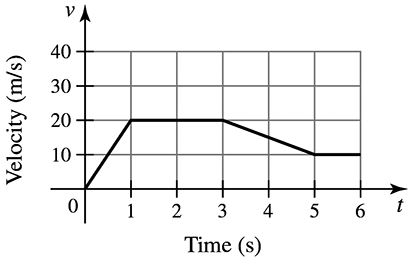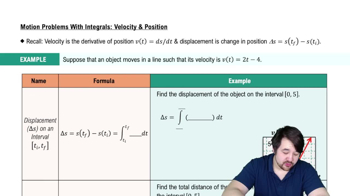Estimate the value of the definite integral using five subintervals and the left endpoint approximation, given that .
Table of contents
- 0. Functions7h 52m
- Introduction to Functions16m
- Piecewise Functions10m
- Properties of Functions9m
- Common Functions1h 8m
- Transformations5m
- Combining Functions27m
- Exponent rules32m
- Exponential Functions28m
- Logarithmic Functions24m
- Properties of Logarithms34m
- Exponential & Logarithmic Equations35m
- Introduction to Trigonometric Functions38m
- Graphs of Trigonometric Functions44m
- Trigonometric Identities47m
- Inverse Trigonometric Functions48m
- 1. Limits and Continuity2h 2m
- 2. Intro to Derivatives1h 33m
- 3. Techniques of Differentiation3h 18m
- 4. Applications of Derivatives2h 38m
- 5. Graphical Applications of Derivatives6h 2m
- 6. Derivatives of Inverse, Exponential, & Logarithmic Functions2h 37m
- 7. Antiderivatives & Indefinite Integrals1h 26m
- 8. Definite Integrals4h 44m
- 9. Graphical Applications of Integrals2h 27m
- 10. Physics Applications of Integrals 3h 16m
- 11. Integrals of Inverse, Exponential, & Logarithmic Functions2h 34m
- 12. Techniques of Integration7h 39m
- 13. Intro to Differential Equations2h 55m
- 14. Sequences & Series5h 36m
- 15. Power Series2h 19m
- 16. Parametric Equations & Polar Coordinates7h 58m
8. Definite Integrals
Estimating Area with Finite Sums
Problem 5.1.71a
Textbook Question
Displacement from a velocity graph Consider the velocity function for an object moving along a line (see figure).
(a) Describe the motion of the object over the interval [0,6].

 Verified step by step guidance
Verified step by step guidance1
Observe the velocity graph, which shows the velocity of the object (in m/s) as a function of time (in seconds). The graph consists of linear segments over the interval [0,6].
From t=0 to t=1, the velocity increases linearly from 0 m/s to 20 m/s. This indicates the object is accelerating uniformly during this time.
From t=1 to t=3, the velocity remains constant at 20 m/s. This indicates the object is moving at a constant velocity, covering equal distances in equal time intervals.
From t=3 to t=5, the velocity decreases linearly from 20 m/s to 10 m/s. This indicates the object is decelerating uniformly during this time.
From t=5 to t=6, the velocity remains constant at 10 m/s. This indicates the object is moving at a constant velocity again, but at a slower speed compared to the interval [1,3].
 Verified video answer for a similar problem:
Verified video answer for a similar problem:This video solution was recommended by our tutors as helpful for the problem above
Video duration:
2mPlay a video:
Was this helpful?
Key Concepts
Here are the essential concepts you must grasp in order to answer the question correctly.
Velocity
Velocity is a vector quantity that describes the rate of change of an object's position with respect to time. It includes both speed and direction. In the context of the graph, the velocity values indicate how fast the object is moving at different times, which is crucial for understanding its motion.
Recommended video:

Derivatives Applied To Velocity
Displacement
Displacement is the overall change in position of an object, calculated as the area under the velocity-time graph. It can be positive, negative, or zero, depending on the direction of motion. By analyzing the graph, one can determine the total displacement over the interval [0,6] seconds by summing the areas of the shapes formed under the curve.
Recommended video:

Using The Velocity Function
Intervals of Motion
Intervals of motion refer to specific time segments during which the object's velocity remains constant or changes. In the given graph, different segments indicate periods of acceleration, constant velocity, and deceleration. Understanding these intervals helps in describing the object's motion accurately over the specified time frame.
Recommended video:

Derivatives Applied To Velocity

 7:59m
7:59mWatch next
Master Estimating the Area Under a Curve Using Left Endpoints with a bite sized video explanation from Patrick
Start learningRelated Videos
Related Practice
Multiple Choice
3
views
